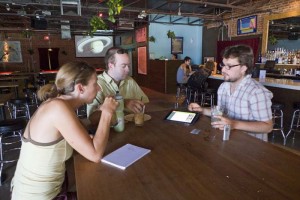 Figuring out just how many people are riding around the region might get a little easier is local bike planners have their way.
Figuring out just how many people are riding around the region might get a little easier is local bike planners have their way.
Planners from the City of Tucson and Pima Association of Governments met with a representative from Eco Counter, a French company that sells automatic bike and pedestrian counters on Saturday.
Eco Counter salesman Jean-Francois Rheault was in Arizona to help install a counter near Sedona. He came to Tucson to meet with PAG’s Ann Chanecka and Tucson’s Tom Thivener. Matt Zoll, Pima County’s bike and pedestrian program manager, said he couldn’t make the meeting, but was interested in the technology.
According to Rheault, the company offers several different counters, some are permanent and some can be moved around the region.
Rheault said various options like modems for wireless data transfer and other additional equipment make it hard to offer a specific price without looking at the intersection where the device will be installed. He did say the prices generally range from about $2,000 to $4,500.
Chanecka said they are investigating sources to fund the purchase of three or four configurations, but isn’t sure how successful they will be.
Thivener said he wanted to get a few up and running quickly.
“I think it is solid technology,” Thivener said. “I think we need to get a pilot program in Tucson as soon as we can to test these things out on some of our busy corridors.”
The potential locations include: The Rillito River path at the Mountain Avenue bridge, Mountain Avenue and Helen Street, Third Street and Campbell Avenue, The Highland bike path at the mall on the University of Arizona campus, Park Avenue and University Boulevard and St. Mary’s Road and I-10.
Chanecka and Rheault rode to several of the locations they are considering, but said some of them have serious challenges.
Chanecka said the Park and University and Third Street and Campbell Avenue locations are too wide for permanent counters and would require temporary counters, which use two rubber tubes to track the number of cyclists that pass over them.
Installing the wires used with the permanent bike counter in the bike lane at Mountain Avenue and Helen Street is problematic because of the pavers that separate the bike path from the travel lane.
Because of those challenges, Chaneka said she is proposing permanent installations at the Rillito River path and at the bike crossing signal at Third Street and Country Club Road. She will also request one mobile counter, which she said they could move around every couple months.
It is the mobile counters that Zoll is most interested in.
“With the versatility of being able to move a device around — that could be helpful for special counts both before and after,” Zoll said. “You know a project is being done and you want to get a sense to see how it affects things.”
Zoll said it could also help with justifying projects by showing there are already cyclists using the area, but that with better facilities, the numbers could be increased.
Thivener said having the data available would be helpful in a lot of ways.
“It is always good to have statistics, whether you are going after grants or just summarizing what the scene is like,” Thiverner said. “I think it would be great for everything we do.”
Chanecka said the automatic counters would give planners a clearer picture about when and where people are riding.
“The manual counts are such a short snap shot in time and are very weather dependent,” Chanecka said. “It is so tough to get an accurate view of the cycling behavior as far as numbers go. The automated count will give is a very clear picture of variation throughout the day, throughout the week, differences in the weekends, and then throughout different months of the year and over time year after year.”
Zoll said he wasn’t sure how useful the data would be from a permanent counting location.
“What do we actually do with the data, I am not sure,” Zoll said. “You can say, this particular pathway does have tremendous use and that is great. Does it change over time? You could look at trends.”
What each of the planners agree on is that manual counts won’t be replaced by automatic counters because they can’t collect other data like helmet use, gender and type of cyclist.
Tom Thivener said it shouldn’t be hard to get a couple counters in the region, but wasn’t sure whether the community would want more than that.
“To get one or two locations, I don’t think is going to be a problem,” Thivener said. “To get a more comprehensive program with multiple locations, that is yet to be seen if that is desired by the community. Like anything it comes down to money and priorities.”
What other locations around the region would you be curious about knowing how many people are riding ?
Check out Eco Counter’s video about their products:

I’d like to see a counter at Cushing Street and Convent Avenue as well as one somewhere along Fourth Avenue. Maybe the intersection at Fourth Ave. and Ninth Street.